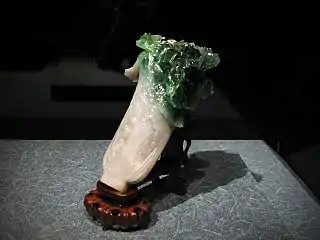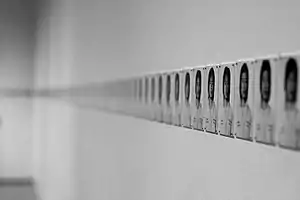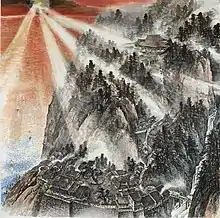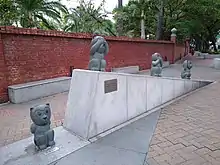Taiwanese art
The artistic heritage of Taiwan is extremely diverse with multiple major influences and periods. Today Taiwan is one of the world's most significant art markets.
History



Stonecutters of the Changbin culture began to make art on Taiwan at least 30,000 years ago. Around 5,000 years ago jade and earthenware works started to appear. Art was first institutionalized in Taiwan during the Japanese Colonial period with the establishment of public schools dedicated to the fine arts. The Japanese introduced oil and watercolor paintings to Taiwan and Taiwanese artists were heavily influenced by their Japanese counterparts. As was typical of colonel rulers the Japanese did not establish tertiary institutions for art education in Taiwan, all students wishing to pursue an advanced degree in the arts had to travel to Japan to do so.[1]
When the Nationalists fled to Taiwan in 1949 they brought many of China’s most prestigious artists and a large portion of the former Qing Imperial art collection with them. The artists Huang Chun-pi, Pu Ru, and Chang Dai-chien who all came to Taiwan during this period are collectively known as the “three masters from across the strait.” The Nationalists also established the first art colleges and universities in Taiwan. Along with Chinese influences the Nationalists also allowed the United States to establish a series of military bases in Taiwan, American pop culture and artistic ideas such as abstract expressionism were introduced to Taiwan by the Americans. Schools such as the May Art Association, a revolutionary art group, and Eastern Art Association, an avant-garde group flourished during this time.[1] The Ton-Fan group, founded in Taipei in 1956 by eight artists, brought abstraction to Taiwan. The Ton-Fan group reacted to Government disapproval of avant-garde art by championing it.[2]
The next major influence came when the ROC left the United Nations in 1971, this unmooring from the international community caused artists to search for an identity and a sense of self, a search which continues up to the present.[3] Artists of this era such as Lee Shi-chi and Shiy De-jinn adopted Taiwanese folk motifs and other elements from Taiwan’s traditional culture however the Taiwanese art scene still chafed under the KMT’s military dictatorship.[1]
Democratization in the late 1980s and the lifting of martial law granted Taiwanese artists freedom of expression for the first time in history. The economic boom of the '80s and ‘90s also saw the financial resources of Taiwanese museums and patrons increase significantly. As Taiwan’s art scene matured there began to be a greater specialization in exhibit spaces with dedicated museums for things like photography and ceramics opening. In the 21st century Taiwan’s artistic community embraced new technologies and new mediums.[1] Many contemporary Taiwanese artists grapple with issues of globalization in their work.[4] LGBTQ artists in modern Taiwan enjoy a degree of freedom denied in other Asian countries. This has made Taiwan a haven and a hub for both domestic and international LGBTQ artists.[5]
Art market

Art collecting has a long tradition in Taiwan, however most important and deep-pocketed Taiwanese collectors prefer to fly under the radar. Taiwanese collectors are significant buyers of Chinese contemporary art as well as antiquities.[6] Both Sotheby’s and Christie’s routinely tour the highlights of their spring and autumn Impressionist and Modern and postwar sales in Taipei.[7] Taiwanese collectors have significant presence both at home and abroad, Taiwanese billionaire collector Pierre Chen is auction house Sotheby’s go-to guarantor for big-ticket items.[8] Taiwanese-German collector Maria Chen-Tu is one of the largest collectors of German art and is also active in Taiwan. In 2019 more than three hundred million dollars worth of artwork that she had loaned for exhibition in China went missing.[9]
By 1990 the Taiwanese art market was the biggest in Asia and served as a regional hub.[10] By 2000 Hong Kong and Taiwan held comparable shares of the market.[6] In the 21st century while no longer the largest art market in Asia (having been surpassed by China) the tastes of Taiwan’s collectors have matured and Taiwan remains the most cutting edge art market in Asia.[11]
Taiwanese art, especially contemporary Taiwanese art, is seen as highly collectable and there is significant international demand for it. The Taiwanese government has worked to support domestic artists on the international stage.[12]
Performing arts
The Taiwanese government believes that "A country’s level of democracy is reflected in the development of its performing arts."[13]
Completed in 2018 National Kaohsiung Center for the Arts is the largest performing arts center in the world.[14][15]
Glove puppetry
Glove puppetry has a long history in Taiwan and is considered one of the country's traditional arts.[16]
References
- Chung, Oscar (January 2020). "Beauty in Diversity". taiwantoday.tw. Taiwan Today. Retrieved 27 January 2020.
- Yao, John. "Catching Up with Taiwanese Art". hyperallergic.com. Hyperallergic. Retrieved 24 April 2020.
- "Place/Displace: Three Generations of Taiwanese Art". pacificasiamuseum.usc.edu. USC Pacific Asia Museum. Retrieved 28 January 2020.
- Brooks, Katherine. "14 Reasons Taiwan Is A Rising Power In The Art World". www.huffpost.com. Huffington Post. Retrieved 27 January 2020.
- Holland, Oscar. "Why gay-friendly Taiwan is a creative haven for LGBTQ art". www.cnn.com. CNN. Retrieved 1 July 2020.
- Adam, Georgina (2019-01-11). "Taiwan's art market: matters of taste". www.ft.com. Financial Times. Retrieved 28 January 2020.
- Kinsella, Eileen (2019-01-17). "Meet 8 Influential Collectors Behind Taiwan's Growing Art Scene". news.artnet.com. Art Net. Retrieved 28 January 2020.
- Schachter, Kenny (2019-06-19). "After Scooping the World on 'Salvator Mundi,' Kenny Schachter Has More to Reveal About the Leonardo—and Art Basel's Biggest Deals, Too". news.artnet.com. Art Net. Retrieved 28 January 2020.
- Brown, Kate (2019-11-20). "$300 Million Worth of Work by Anselm Kiefer and Other German Artists Has Mysteriously Gone Missing in China". news.artnet.com. Retrieved 28 January 2020.
- Chow, Vivienne (2020-01-24). "Taipei Was Asia's Biggest Market Hub 30 Years Ago. Can a Coterie of Art-World Insiders Return It to Its Former Glory?". news.artnet.com. Artnet. Retrieved 27 January 2020.
- Goldstein, Andrew (2019-01-28). "Where Is Asia's Art Market Headed? Taiwan's New Taipei Dangdai Fair Shows a Region on the Verge of Massive Change". news.artnet.com. Artnet. Retrieved 27 January 2020.
- Ingram Allen, Jane. "5 Taiwanese artists going global". artradarjournal.com. Art Radar. Retrieved 28 January 2020.
- Writer, Staff. "Performing arts indicate democracy, official says". www.taipeitimes.com. Taipei Times. Retrieved 12 July 2020.
- Lavars, Nick. "World's largest performing arts center opens in Taiwan". newatlas.com. New Atlas. Retrieved 12 July 2020.
- Treviño, Julissa. "Taiwan Is Now Home to the World's Largest Performing Arts Center". www.smithsonianmag.com. Smithsonian Magazine. Retrieved 12 July 2020.
- "Literature and Art". eng.taiwan.net.tw. Taiwan.net. Retrieved 12 July 2020.